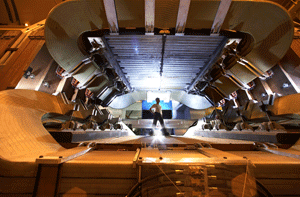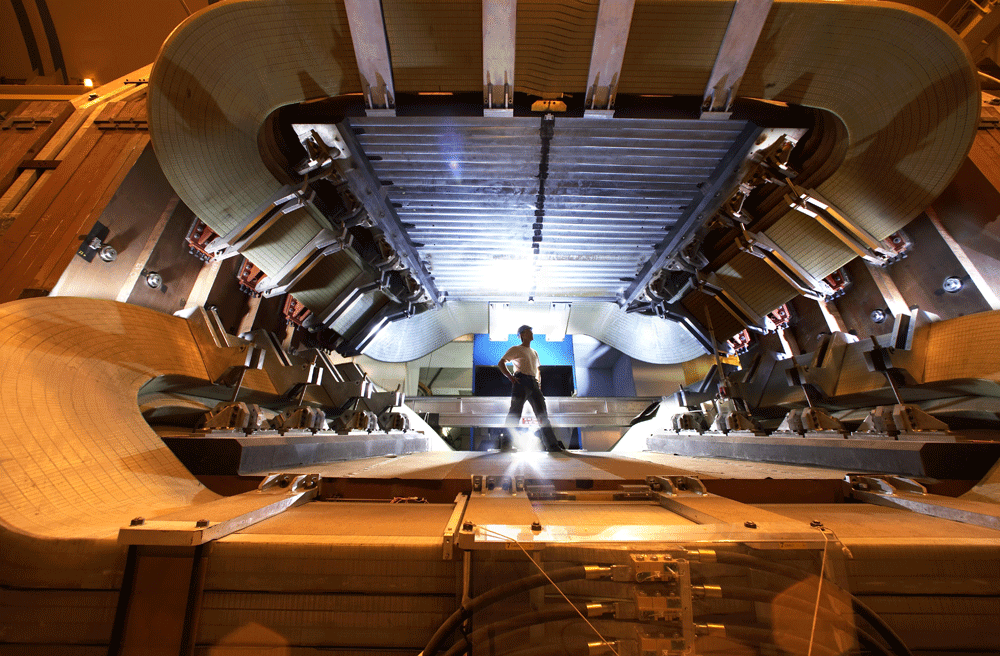Charm and Anticharm—Not Quite the Same
From what we can observe, there is no symmetry between matter and antimatter in the Universe. All structures, from unimaginably large clusters of galaxies to microscopic human cells, are made of matter: protons, neutrons, and electrons. Though it is possible to produce antimatter—antiprotons, antineutrons, and positrons—in high-energy particle collisions, and even make medical use of positrons, antimatter seems to have disappeared from the Universe at large.
So far, all experimentally observed differences between the way matter and antimatter behave are well explained by the standard model of particle physics. When applying this theory to the behavior of matter and antimatter in the early Universe, however, the differences are far too little to explain the asymmetry observed today. Now, in a paper appearing in Physical Review Letters, the Large Hadron Collider beauty (LHCb) collaboration at CERN has found a difference in the decay properties of D mesons and their antiparticles that is perhaps too large to be explained by the standard model [1]. If future experiments support the team’s finding, which is currently not statistically significant enough to be heralded a “discovery,” it may turn out to be a milestone in understanding the disappearance of antimatter in the Universe.
The first clue to explaining the asymmetry between matter and antimatter came in 1964 from an experiment by Christenson, Cronin, Fitch, and Turlay [2]. They studied K mesons, particles made up of a strange quark and a down antiquark (or a down quark and a strange antiquark). By observing the decays of long-lived K mesons into pairs of π mesons (pions), the team established that some type of interaction acts with different strength on particles and their antiparticles. Their findings showed that the symmetry between particles and antiparticles—known as charge-parity or CP symmetry—is broken in nature. Three years after this discovery, Andrei Sakharov showed that such CP violation can, in principle, explain how the Universe evolved from an initial state with exactly equal amounts of matter and antimatter, to the present Universe, with only matter [3].
Another breakthrough came in 1973. At that time, the list of known quarks included the up, down, and strange quarks and the then hypothesized charm quark, which wasn’t discovered until 1974. Kobayashi and Maskawa argued that the standard model weak interactions, which are responsible for nuclear beta decay, would violate CP, provided there were more quarks than these four [4]. To mathematically make room for CP violation, Kobayashi and Maskawa’s theory needed a third generation: the bottom and top quarks, the tau lepton, and tau neutrino, all of which were eventually discovered.
In its current form, the standard model with three generations of quarks is able to explain how antimatter disappeared from the Universe within a fraction of the first second after the big bang. But the difference between the way that weak interactions affect matter and antimatter is much too tiny, “predicting” an amount of surviving matter that would not have sufficed to make even one galaxy, let alone the estimated one trillion galaxies in the observable Universe. As a result, physicists have stopped asking “Why did antimatter disappear?” and have started asking “Why did matter survive?” [5].
This conundrum has led theorists to speculate about new theories, beyond the standard model, where CP is sufficiently strongly violated that more matter could survive in a big bang scenario. For their part, experimentalists have sought to measure more and more CP asymmetries—processes where the rate of some meson decays into final particles is different from the rate of the corresponding antimeson decay into the corresponding final antiparticles—hoping to find traces of such new interactions. In particular, the two highly successful “B-factory” experiments, Belle at KEK in Japan, and Babar at SLAC in California, measured numerous such asymmetries in B-meson decays during the last decade. Yet all their measurements fit nicely into the Kobayashi-Maskawa theory of CP violation. In other words, no experiments have produced evidence of new sources of CP violation, beyond the weak interaction.
Enter LHCb’s experiment. It can measure CP asymmetries in the decays of bottom-carrying mesons and charm-carrying mesons. The big advantage of the LHCb experiment is that it can exploit the huge number of collisions provided by the LHC. With more collisions, the team can acquire higher statistics, achieve better precision, and, consequently, has a better chance at discovering CP asymmetries that have eluded previous measurements. What they find is that D mesons decay into K+K- pairs slightly less often than anti- D mesons do; while D mesons decay into π+π- pairs slightly more often than anti- D mesons. (Because of an asymmetry in the number of D mesons and anti- D mesons produced, the LHCb experiment does not measure the asymmetries in the decays into K+K- and into π+π- separately, but only the difference between them. The difference measurement thus cancels out the systematic error related to the production asymmetry.) Information from other experiments, such as the CDF experiment in Fermilab [6], supports the LHCb result and suggests that the two asymmetries are similar in size and opposite in sign.
The LHCb measurement provides the first evidence for CP violation in decays of mesons containing the charm quark. What makes this particular measurement so interesting, though, is that the size of the asymmetry, almost a percent, is unexpectedly large. The D meson is made of the second-generation charm quark, and the first-generation up antiquark. For weak interactions to generate CP violation in a D-meson decay, the third generation, more specifically the bottom quark, must be involved. But the couplings of the weak force carrier, the W boson, to a bottom-charm pair and to a bottom-up pair, are very small, such that the CP asymmetry expected by theorists is only of order 10-3, rather than the 10-2 observed by LHCb. Are we at last getting the much-awaited clue from experiments for new CP-violating interactions?
The problem is that we can’t be sure the theoretical prediction is right because calculating charm decay rates is notoriously difficult. The problem has to do with the fact that, even though these decays are mediated by the weak interactions, strong interactions necessarily play a role as they bind the quarks into mesons. For the heavy bottom-carrying meson decays, and for the light strange-carrying meson decays, we can often apply rigorous theoretical methods, based on approximate symmetries, that help in carrying out reliable calculations. But the charm-carrying mesons are somewhere in between, leaving theorists at a loss when aiming at better than an order of magnitude precision in their calculations. More often than not, it seems that the strong interactions affect the charm quark as if it were heavy, so that theoretical estimates are not that far from measured rates. Currently, however, there is no rigorous way to rule out the possibility that strong interaction effects enhance the bottom-quark-related contribution to the D to K+K- and D to π+π- decays by a large enough amount to generate the same asymmetry as the one observed by LHCb.
This situation should not, and does not, stop theorists from thinking about what new physics could generate an asymmetry of order of a percent. The two relevant decay modes have long been known to be sensitive to new physics effects, much more so than other D-meson decays [7]. It is difficult to expect much progress in calculating the standard model prediction for the asymmetry with a precision that would make a convincing case for either standard model or new physics effects. The best way to make progress (in addition to achieving the experimental accuracy necessary to claim a discovery) seems to be by examining candidate theories of new physics. If these theories suggest, as they usually do, deviations from the standard model in other processes, we will have better guidance in looking for additional clues [8]. For example, a large class of supersymmetric models can account for a CP asymmetry of order of a percent [9], and suggests that related effects might be observed in searching for the electric dipole moment of the neutron. Of course, direct discoveries by the ATLAS and CMS experiments will certainly help.
The statistical significance of the LHCb measurement is about 3.5 σ. To claim a discovery, a 5 σ significance is required. If the LHCb measurement turns into a discovery, then there are two possible theoretical scenarios. It can be the standard model that generates the CP asymmetry, in which case we learn an interesting, and somewhat surprising, lesson about the way in which strong interactions can affect charm decays. If it is new physics that generates the CP asymmetry, then LHCb’s measurement is more than the first manifestation of this new physics; it can be a first step towards solving the mystery of the missing antimatter.
References
- R. Aaij et al. (LHCb Collaboration), Phys. Rev. Lett. 108, 111602 (2012)
- J. H. Christenson, J. W. Cronin, V. L. Fitch, and R. Turlay, Phys. Rev. Lett. 13, 138 (1964)
- A. D. Sakharov, Pisma Zh. Eksp. Teor. Fiz. 5, 32 (1967); [JETP Lett. 5, 24 (1967)]
- M. Kobayashi and T. Maskawa, Prog. Theor. Phys. 49, 652 (1973)
- For a popular account, see H. R. Quinn and Y. Nir, “The mystery of the missing antimatter,” (Princeton University Press, Princeton, 2008)[Amazon][WorldCat]
- http://www-cdf.fnal.gov/physics/new/bottom/120216.blessed-CPVcharm10fb/cdf10784.pdf
- Y. Grossman, A. L. Kagan, and Y. Nir, Phys. Rev. D 75, 036008 (2007)
- G. Isidori, J. F. Kamenik, Z. Ligeti, and G. Perez, arXiv:1111.4987(hep-ph)
- G. F. Giudice, G. Isidori, and P. Paradisi, arXiv:1201.6204(hep-ph)





